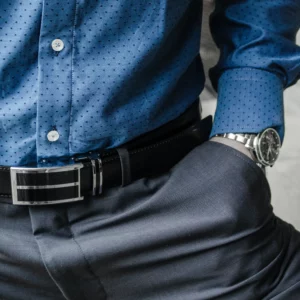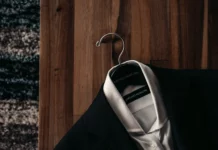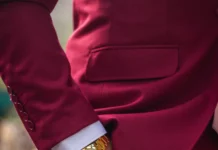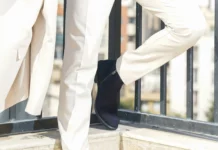The world of men’s fashion has been steadily evolving, capturing more and more attention over time. Nowadays, guys are taking style seriously, and how you present yourself matters. Style isn’t just about looking good; it can boost your mood and self-esteem.
When it comes to wearing a suit, the addition of a belt brings sophistication, elegance, and a touch of formality to your ensemble. It’s also a powerful way to express your personal style, instantly setting you apart from the crowd. And let’s not overlook its practicality – a belt plays a key role in adjusting and securing those suit pants, ensuring both a great fit and comfort. So, do you wear a belt with a suit? Should you wear a belt with a suit? Let’s dive in.
The Pros of Wearing a Belt with a Suit
 A well-picked belt does more than just hold your pants up; it’s a style enhancer, elevating your entire suit game. It’s the missing puzzle piece that brings the whole look together, adding a touch of elegance and polish. From leather classics that match your shoes to textured fabric options that catch the eye, or even a subtle pop of color to break the monotony – the right belt takes your outfit to new heights, making a statement about your style and attention to detail.
A well-picked belt does more than just hold your pants up; it’s a style enhancer, elevating your entire suit game. It’s the missing puzzle piece that brings the whole look together, adding a touch of elegance and polish. From leather classics that match your shoes to textured fabric options that catch the eye, or even a subtle pop of color to break the monotony – the right belt takes your outfit to new heights, making a statement about your style and attention to detail.
For those with a more robust physique, a belt is a secret weapon. It defines your waist, giving your silhouette a structured, tailored appearance. By cinching at the waist, it creates a pleasing contrast between the upper and lower body, achieving balance and proportion. The belt accentuates your natural waistline, emphasizing your masculine shape. Plus, it adds a sense of structure and refinement to your overall look, making you appear sharp and well-put-together. Whether you opt for a wider belt for a bold statement or a narrower one for subtlety, it’s a reliable tool for defining your waist and boosting your style.
Now, let’s talk belt buckles – these little details can add a whole lot of coolness to your ensemble, showcasing different style options.
On a practical note, a belt is your ally against sagging or slipping pants. It keeps you comfortable all day, sparing you the need to constantly check if your trousers are behaving. With a belt, you maintain a neat and functional appearance without hassle, ensuring you look your best throughout the day. So, do you wear a belt with a suit? Absolutely. Should you wear a belt with a suit? Without a doubt. It’s a style essential that keeps you looking sharp and feeling confident.
When It Might Be Okay to Skip the Belt
Some suit styles, like the double-breasted suit, are meant to be beltless, and the appropriateness depends on the occasion. Formal black-tie events usually call for a single-breasted suit sans the belt. These occasions have strict dress codes favoring a more classic and streamlined appearance. No belt accentuates the suit’s sleek and sophisticated look, keeping the focus on overall elegance. By choosing a beltless suit style, you honor the event’s protocols, demonstrating your understanding and respect while maintaining a refined appearance.
If your suit fits like a glove and the trousers sit snugly on your waist without any looseness or sag, you can consider going belt-free. A well-tailored suit that hugs your body in all the right places creates a clean, streamlined look, negating the need for a belt. By ditching the belt, your suit retains its sleek silhouette, allowing the impeccable fit to shine, showcasing your attention to detail and sartorial sophistication.
Now, if you’re not a fan of belts, there are stylish alternatives. Suspenders add a dash of vintage charm while holding your trousers securely in place and crafting a distinctive look. On the flip side, side-adjuster trousers provide a tailored and neat appearance with adjustable tabs or buttons for a custom fit. Whether you opt for suspenders or side-adjuster trousers, these waistline options offer versatility and inject a unique touch into your outfit, all while keeping you comfortable and showcasing your individual style. So, when is it okay to skip the belt? In these scenarios, it’s more than okay—it’s a stylish choice.
When Wearing a Belt Is Required
 When it comes to choosing between suspenders, side-adjuster trousers, or a belt, you’ve got stylish options that offer both comfort and a touch of flair. Suspenders bring a hint of vintage charm, ensuring your trousers stay in place while crafting a unique look. On the flip side, side-adjuster trousers provide a tailored and clean appearance with adjustable tabs or buttons for a personalized fit. Whether you go for suspenders or side-adjuster trousers, these waistline choices offer versatility and inject a distinctive element into your outfit, all while keeping you comfortable and showcasing your individual style.
When it comes to choosing between suspenders, side-adjuster trousers, or a belt, you’ve got stylish options that offer both comfort and a touch of flair. Suspenders bring a hint of vintage charm, ensuring your trousers stay in place while crafting a unique look. On the flip side, side-adjuster trousers provide a tailored and clean appearance with adjustable tabs or buttons for a personalized fit. Whether you go for suspenders or side-adjuster trousers, these waistline choices offer versatility and inject a distinctive element into your outfit, all while keeping you comfortable and showcasing your individual style.
And what about the belt? It’s more than just an accessory; it’s the finishing touch that adds integrity to your suit and brings your look together seamlessly. It provides closure, ensuring your outfit ends on a high note. Belts serve as a connecting element between the top and bottom halves of your attire. Moreover, they can be used strategically to accentuate or conceal certain areas of your body, depending on how you adjust them. So, when is wearing a belt required? When you want to give your ensemble that final, polished touch and create a cohesive and well-defined look.
Practical Considerations
Coordinating the colors of your belt and shoes is a must, and it’s not just a small detail; it’s the secret sauce for a harmonious and well-put-together look. When your belt matches your shoe color, it’s a clear sign of attention to detail and a mark of refined style. This synchronization between belt and shoes creates a balanced and cohesive appearance, taking your entire outfit to the next level. A belt that complements your shoe color enhances the visual flow and showcases your knack for coordination. Whether it’s the classic black belt with black dress shoes for a formal affair or a brown belt harmonizing with brown leather loafers for a more casual outing, this thoughtful pairing elevates your ensemble, exuding sophistication and fashion savvy. So, when it comes to belt and shoe colors, should you wear a belt with a suit? Absolutely, and make sure they’re in sync to showcase your impeccable style effortlessly.
Now, let’s talk belt width and buckle style. These factors matter for both the formality of your suit and personal preferences. For formal occasions, opt for a narrower belt that matches your trouser loops, achieving that sleek and sophisticated look. Pair it with a simple and understated buckle design for a refined appearance. In more relaxed settings, wider belt widths can inject visual interest and make a bolder statement. Experiment with different buckle styles – choose classic designs for formal events and more unique or embellished options to reflect your personal style. Ultimately, the goal is to find a belt that not only complements your suit but also provides a comfortable fit and aligns with your unique fashion sensibilities. So, when it comes to practical considerations, a well-chosen belt is your style ally.
Conclusion
In conclusion, your choice of whether to wear a belt with a suit is a reflection of your style, sophistication, and attention to detail. It’s a versatile accessory that can elevate your look and provide that finishing touch. So, whether you opt for a belt, suspenders, or side-adjuster trousers, remember that your fashion choices speak volumes about your personal style and confidence. Dress well, and wear it with pride.
















